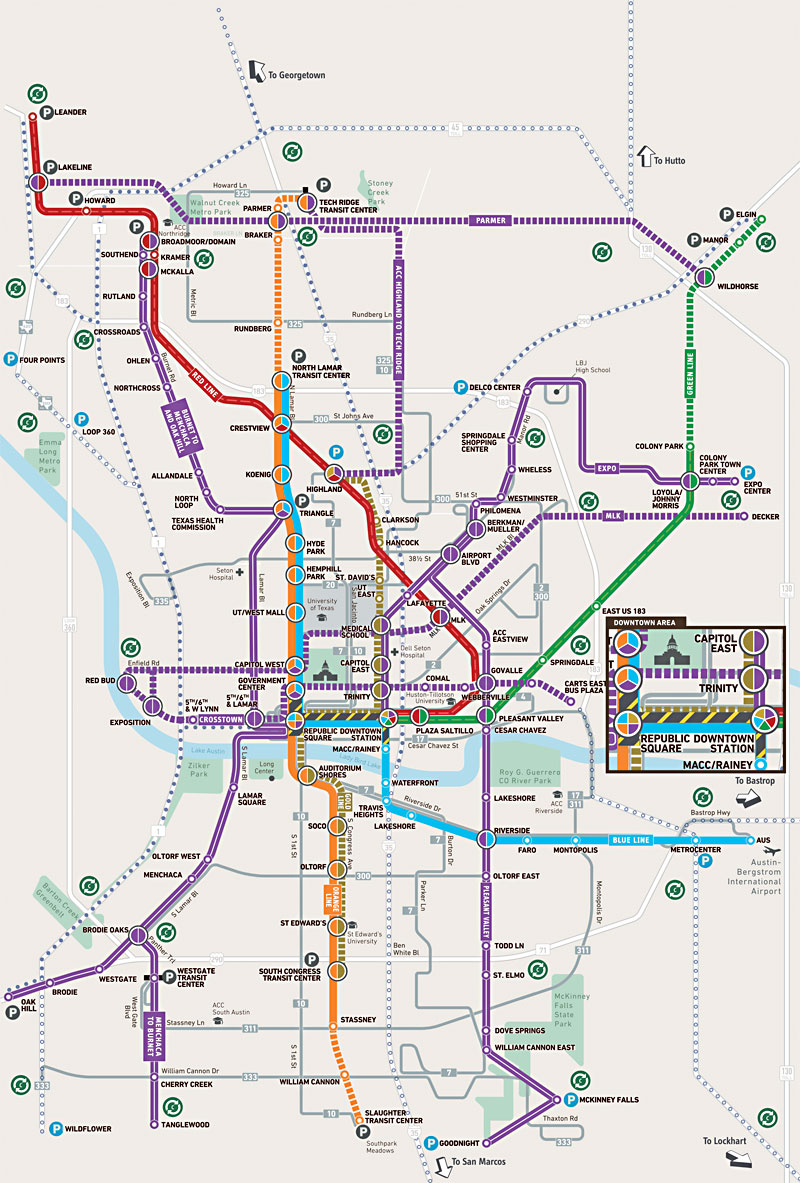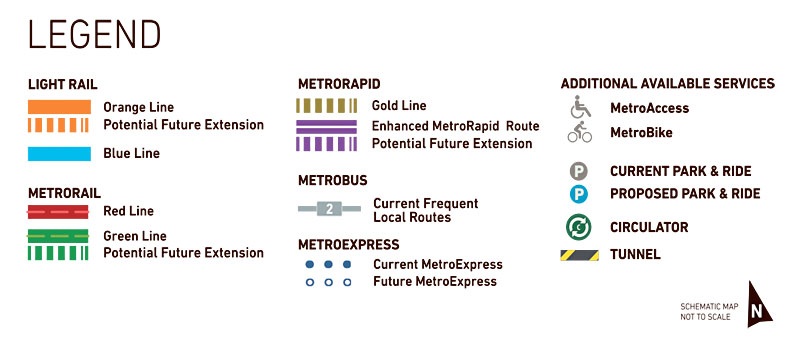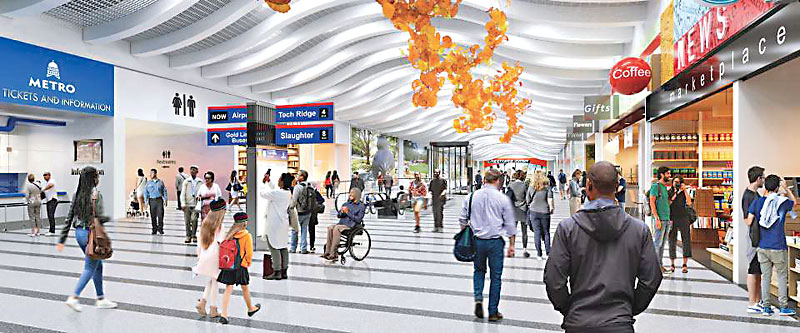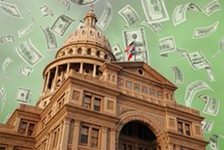From Light Rail to a Downtown Tunnel: The Parts of Project Connect
Diving into the plan
By Mike Clark-Madison, Fri., Sept. 25, 2020
The Project Connect system plan and "initial investment" – the latter being the $7 billion in projects to be funded and operated by the proposed 8.75-cent property tax on the November ballot – are much larger in scope than the transit plans put to voters in 2000 (lost narrowly), 2004 (won handily; that's the MetroRail Red Line), and 2014 (lost handily). This plan combines elements of all three, as well as items that were considered too ambitious back then (like going underground Downtown) but seem worth the effort now, and a $300 million commitment to affordable housing. There's a lot on the table, and much of it is still conceptual; if Proposition A passes, the newly formed Austin Transportation Partnership (a separate agency formed jointly by the city and Capitol Metro) will embark on engineering and environmental studies (under "NEPA" – the National Environmental Policy Act) that are required for federal clearance and federal funding of a projected 45% share of the project costs. – Mike Clark-Madison
LIGHT RAIL
The Orange Line
What is this? The main light rail line, forming the north-south spine of the system, running along the "Guadalamar" alignment from North Lamar Transit Center (at U.S. 183) south to serve the UT campus, Capitol Complex, Downtown, and South Congress to Stassney Lane. It's a route served today by the MetroRapid 801 line.
How much will it cost? $2.5 billion. This doesn't include the cost of the Downtown Tunnel but does include enhanced MetroRapid bus connections at each end – north to Tech Ridge and south to Southpark Meadows. (The "enhanced" part involves street, signal, and intersection improvements as well as the bus service.)
When would it be built? Eight years – one for environmental review (NEPA), two for final design/procurement, five for construction/commissioning of vehicles.
What would come next? The north and south extensions will be cleared through NEPA now so they can be converted to rail in a future phase.
What do we still not know? As the plan was developed, city leaders (including the mayor) strongly suggested that Project Connect not displace existing auto capacity; that's primarily an issue on the Orange Line (and it was a big reason the 2014 plan shied away from this route). The city's Austin Strategic Mobility Plan calls for a protected transitway – no mixed traffic – along the entire Orange Line route.
A perennial quandary faced by planners and transit boosters is how to get past UT along, or perhaps near, the Drag. The city's Guadalupe Street Corridor Plan from 2016 (www.austintexas.gov/guadalupe) calls for dedicated transit lanes, separate bike facilities through West Campus, and two auto travel lanes; should rail be back in the mix, expect more work to be done. There has also been talk of grade-separating the Orange Line, the Red Line, or both at the Lamar/Airport intersection where they would meet. As for south of the river, South Congress is a lot different today than it was in 2000, when opposition from the strip's then-merchants did not help the rail cause; today's heavy traffic and scarce parking make rail a far more popular proposition, but other than the ASMP's call for a dedicated transitway, work is still needed on design. (The Congress Avenue projects in Prop B are mostly north of the river.)
The Blue Line
What is this? Rail to the airport, baby! And from there along the East Riverside Corridor into Downtown. (Technically, the Blue Line would then "interline" with the Orange north of Downtown, which just means there would be twice as many trains on the Orange.)
How much will it cost? $1.3 billion. Again, not including the tunnel but likely including a new bridge across Lady Bird Lake. This route would likely involve more new right-of-way acquisition, though in less developed areas with cheaper land. The city's East Riverside Corridor Plan, adopted way back in 2013 (www.austintexas.gov/riverside), calls for a dedicated transitway.
When would it be built? Eight years – same schedule as the Orange Line.
What would come next? Practically speaking, the Gold Line (see next page).
What do we still not know? As popular as the idea is, rail to the airport is not a surefire ridership driver, and the lengthy end-stretch into AUS won't be cheap; the NEPA analysis and prospective commitment of federal funding will bear close attention. On the other hand, a new Downtown bridge seems a lot less ambitious than it used to, now that Rainey Street, Waller Creek/Waterloo Greenway, the South Shore Waterfront (and Statesman site), and I-35 itself are all being redeveloped around the site of a new lake crossing.
The Downtown Tunnel
What is this? Between 1 and 1.5 miles of subway below Downtown Austin, carrying the light rail lines in a way that "future-proofs" the system, as Cap Metro puts it. According to the planners, meeting peak ridership demand will require longer trains at higher frequencies than can be reliably routed through a crowded Downtown at street level. It would include at least two stations – near the Convention Center (and Cap Metro's surface Downtown Station) and at Republic Square – and possibly more, depending on the length of the north-south piece of the T-shaped tunnel.
How much will it cost? $2 billion. Is that a realistic estimate, given the challenges encountered by the Waller Creek flood control tunnel (which went about 600% over its original, albeit unrealistic, 1998 budget) and the MoPac Improvement Project (which ran into its biggest problems when going below grade)? Good question. Would it be built if the cost estimate, or the engineering in general, proves shaggy? Quite possibly not, given how much federal money is involved. That's what NEPA's for!
When would it be built? Eight years, along with the Orange and Blue lines.
What would come next? The development of the amenities – shops, dining, live music – shown in Cap Metro's renderings; that's all separate, and work on how to manage that, including working with the adjoining property owners, has yet to begin.
What do we still not know? Lots! In addition to the tunnel engineering and the amenities, how the underground stations line up with the bus and commuter rail services still at street level, and how the Orange Line gets back to grade if, as proposed, it crosses the river on the Drake Bridge (South First Street).
BUS SERVICES
The Gold Line
What is this? The Gold Line is the northern leg of the doomed 2014 rail plan (the Blue Line being the southern leg), running north to ACC Highland. In this plan, it's anticipated that it will be rail eventually; because so much of this planned alignment is now in flux, it's starting out as a MetroRapid line, but it will go through NEPA to be cleared for rail development once the time is right, whenever that is.
How much will it cost? $50 million, including the NEPA rail studies.
When would it be built? 3.5 years – one for NEPA, one for final design, 18 months for construction.
What would come next? Someday, another rail line, priced out at $700 million in the system plan.
What do we still not know? We've talked pretty casually about the Gold Line running "up Red River," much of which is now a big hole in the ground where UT is building the new Moody Center; that and lots of other construction on campus, around the Dell Medical School and the old Brackenridge Hospital campus, and in the "innovation district" in Downtown's northeast quadrant throw back on the table discussion of this alignment. The same is true closer to Hancock Center, Airport Boulevard, and ACC Highland (and the Chronicle), where I-35 reconstruction, ongoing redevelopment, and the parallel operation of the Red Line all mean there's a lot more work to do even to figure out how to implement the Gold Line as a bus route, let alone rail.
MetroRapid: Expo Center, Pleasant Valley, Burnet/Menchaca/Oak Hill
What is this? The other three new MetroRapid lines include service from Downtown through East Austin (along Manor Road and Loyola Lane) out to the Travis County Expo Center and Colony Park; from Mueller south along Airport and Pleasant Valley all the way to Goodnight Ranch and McKinney Falls; and from the Domain along Burnet and South Lamar to Brodie Oaks and then (separately) down Menchaca and out to Oak Hill.
How much will it cost? $120 million for all three lines, so each one is individually less than the Gold Line.
When would it be built? Three years – the MetroRapid lines still need NEPA studies, but much smaller in scale, so those only take six months.
What would come next? These three are "Phase I" of MetroRapid expansion; there are four more routes, in two phases, in the full Project Connect system plan.
What do we still not know? Whether MetroRapid service will be enough to connect fast-growing suburban and exurban areas – particularly more transit-dependent ones in the Eastern Crescent – and provide genuine alternatives to driving and car ownership.
Other Bus Services
What are these? The Project Connect initial investment includes new MetroExpress commuter routes into Downtown from Oak Hill, Four Points, and Wildflower Center. It also includes new park-and-rides at the last two of these and at ACC Highland, the Delco Center, the Expo Center, Goodnight Ranch, McKinney Falls, MetroCenter (near the airport), and Loop 360 near RM 2222, and a new transit center, the Eastside Bus Plaza (also served by the Capital Area Rural Transportation System). There are also 15 planned "neighborhood circulator" zones, mostly out in the exurbs; some of these will be on-demand service (like the current Pickup), others may have fixed routes like the old 'Dillos.
How much will this cost? $60 million for the MetroExpress routes and park-and-rides, and another $1.5 million for circulator vehicles.
When would it be built? Ongoing over eight years.
What would come next? The full system plan calls for five additional MetroExpress routes, 15 additional park-and-rides, and 15 more circulation areas. Notably, many of these were planned for outside the Capital Metro service area.
What do we still not know? Whether demand from outside the service area – among cities or districts who'd be contracting directly with Cap Metro for service – would justify this additional investment, or more, or less.
Commuter Rail: Red and Green Lines
What is this? The MetroRail Red Line is the one we have now; the Project Connect plans call for two new stations near the Domain – one at the Austin FC stadium at McKalla Place, and one serving the booming Broadmoor campus. (Cap Metro is already building out other Red Line improvements, including double-tracking to increase capacity.) The Green Line would use the same vehicles and system of tracks as does the Red Line, but would head east from Plaza Saltillo and curve through the Eastern Crescent to Colony Park (where the city is building its new infill project in partnership with Catellus, the team behind Mueller). It could then go further, to Wildhorse, into Manor, and all the way to Elgin.
How much will it cost? $25 million for the new Red Line stations; $370 million for the Green Line to Colony Park.
When would it be built? Red Line stations within three years (presumably McKalla Place would open first). The Green Line would not even begin its NEPA process until eight years from now, and would take another five years thereafter.
What would come next? In addition to Green Line extensions out to Elgin (the line owned by Cap Metro goes all the way to Giddings), there may be new Red Line stations in the future as Williamson County becomes more interested in transit.
What do we still not know? Many otherwise transit-friendly activists have been plenty cool on the Red and Green lines as inefficient ways to spend limited transit dollars for objectively low ridership. Would this remain the case with the development of a more robust multimodal transit system that could drive ridership increases and influence development patterns? Or are the limitations of a service built around century-old train tracks simply too great?
PROPOSITION A: FOLLOW THE MONEY
Proposition A will ask voters to approve an 8.75-cent property tax increase for the Project Connect transit plan, which would amount to $3.85 billion of the $7 billion initial system investment. The remaining amount is expected to be covered by federal dollars. Funded projects (~$7.25 billion) are envisioned to include:
$4.2 billion: Light rail Orange Line from North Lamar Transit Center to Stassney Lane, with enhanced MetroRapid service to Tech Ridge and Southpark Meadows
$2.5 billion: Downtown Transit Tunnel
$1.3 billion: Light rail Blue Line from North Lamar Transit Center to Austin-Bergstrom International Airport
$700 million: MetroRapid Gold Line from Highland Mall to South Congress Transit Center
$370 million: Commuter rail Green Line to Colony Park
$300 million: Anti-displacement efforts due to transit construction
$300 million: Maintenance facility improvements
$200 million: Transit supportive investments
$120 million: New Expo, Pleasant Valley, and Burnet to Oak Hill MetroRapid lines
$100 million: Three new MetroExpress routes, nine park-and-rides, and a new Transit Center
$30 million: Customer technology systems
$25 million: Red Line improvements
$3 million: Neighborhood circulators (15 new zones/vehicles)
Got something to say? The Chronicle welcomes opinion pieces on any topic from the community. Submit yours now at austinchronicle.com/opinion.










